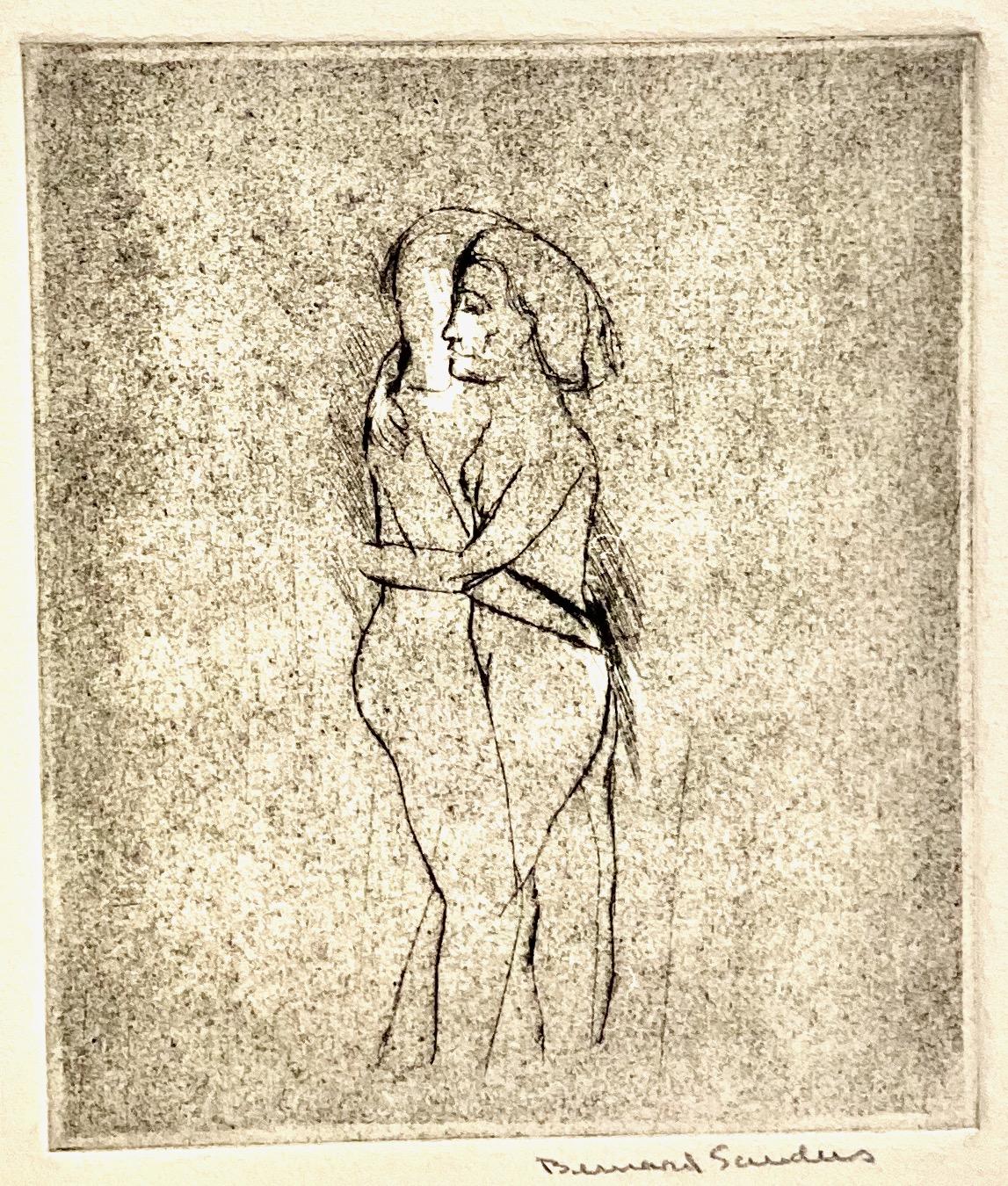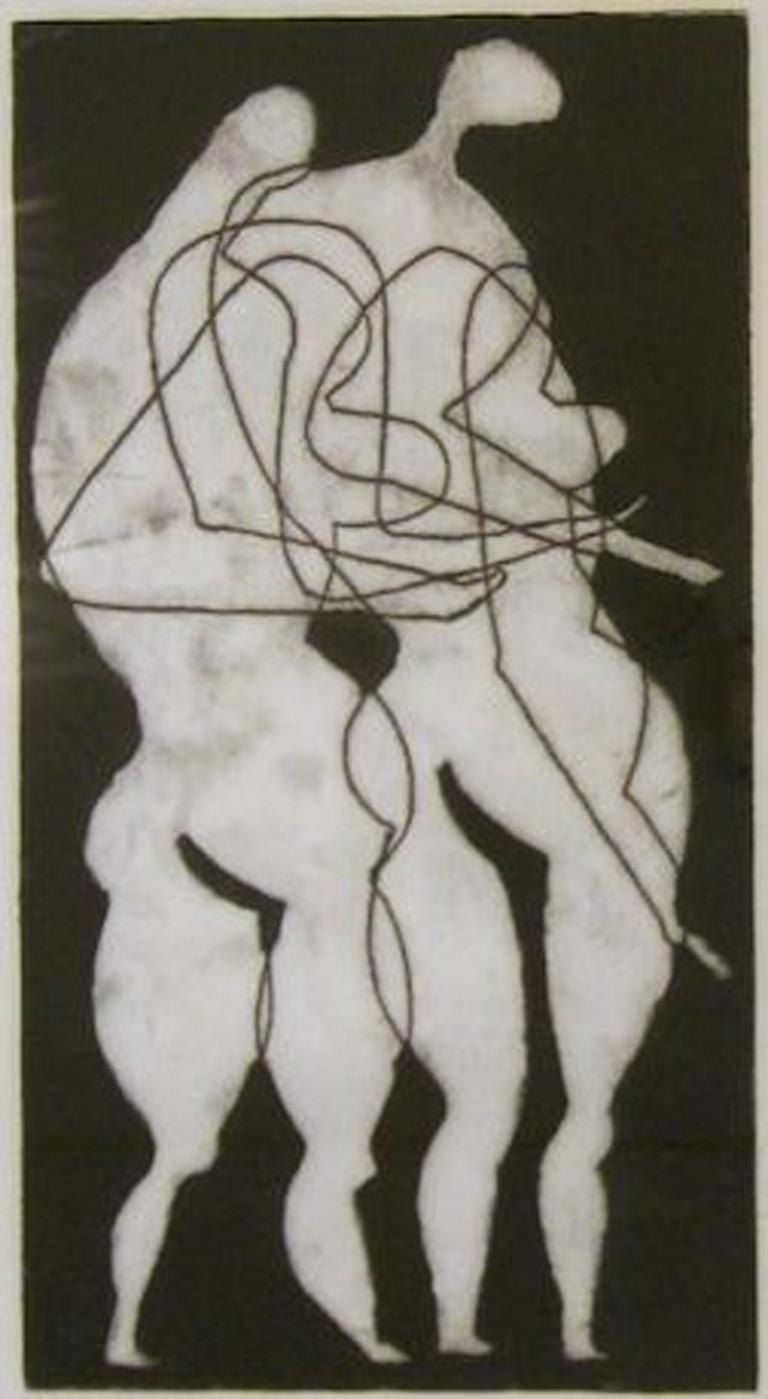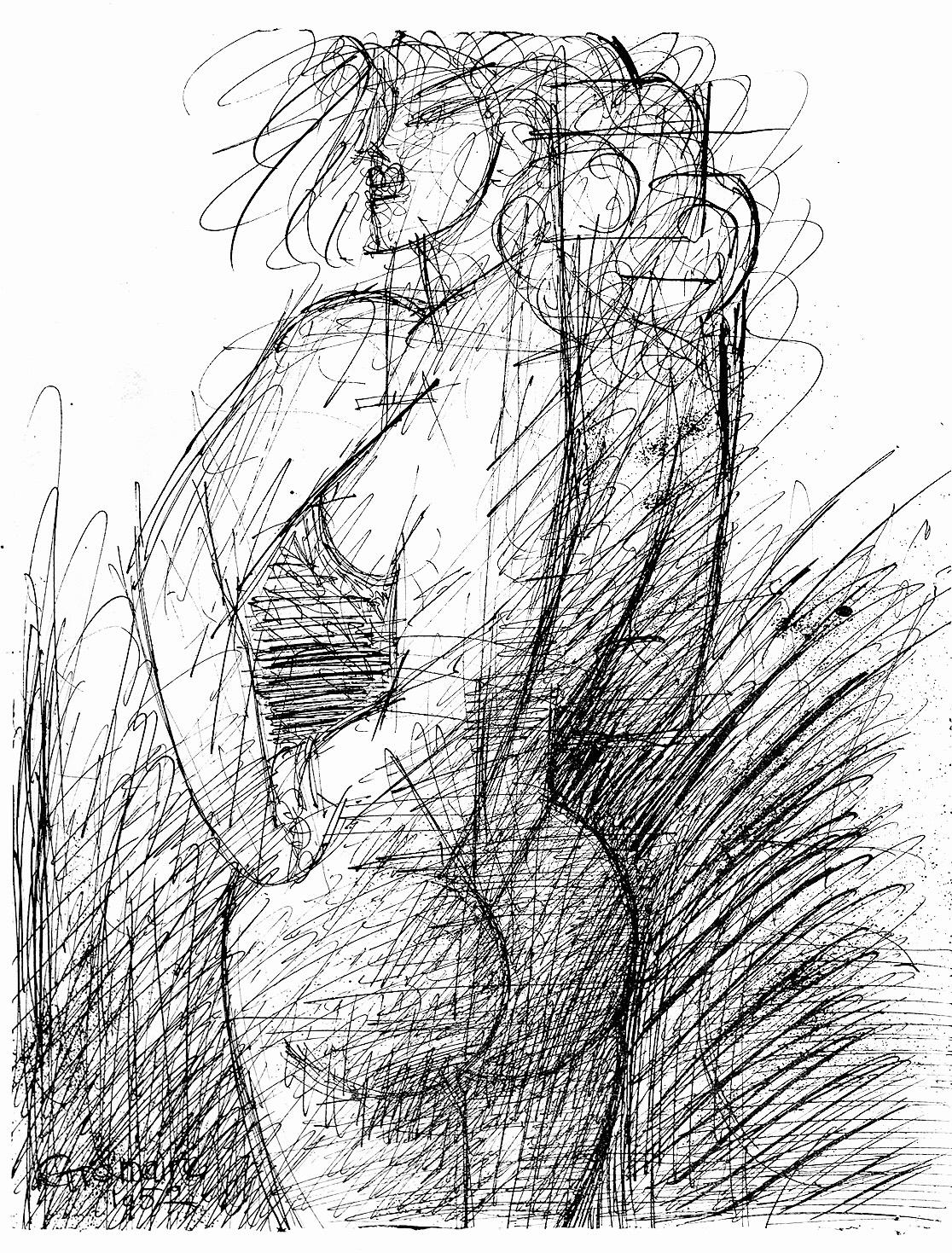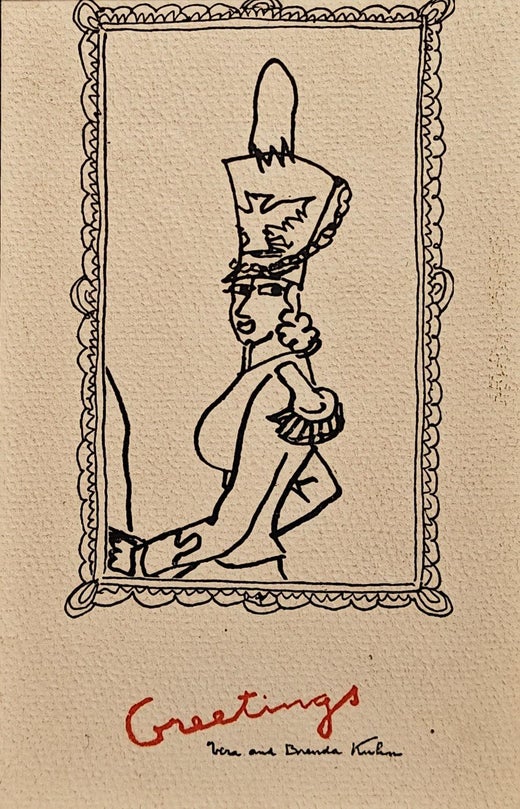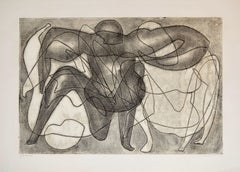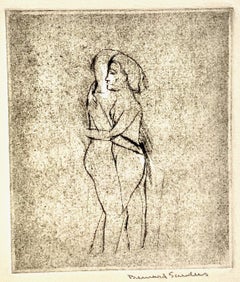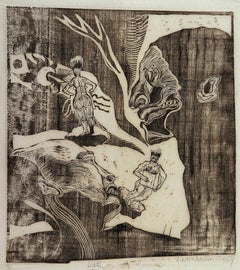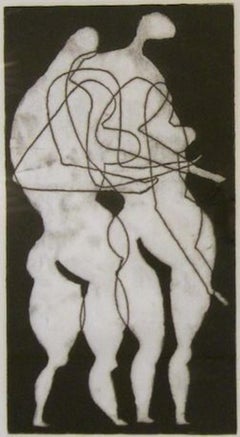Want more images or videos?
Request additional images or videos from the seller
1 of 2
Walt KuhnAdvice1915
1915
$800
£620.42
€705.82
CA$1,144.69
A$1,250.67
CHF 657.78
MX$15,036.18
NOK 8,281.97
SEK 7,775.67
DKK 5,270.47
About the Item
Walt Kuhn (1877-1949), Advice, etching and drypoint, 1915, signed in pencil lower right and titled lower left. In generally good condition but obviously a proof impression, with margins (trimmed irregularly), remains of prior hinging showing through at upper margin, a red ink notation lower margin (“29 Conversation”), 4 3/8 x 2 1/2, the sheet 6 1/8 x 4 5/8 inches.
Provenance: ex Collection: Jonathan Greenberg, New York.
A very good, inky impression of this great rarity. The total number of proofs is about 6 or less, probably 3 or 4. This is listed as number 3 in the Kennedy Galleries Walt Kuhn Checklist, made for an exhibit of his prints in 1967; it is cited as a print where no more than 6 impressions are known to exist.
Advice appears to be a portrait of circus or carnival performers in an off-stage moment.
- Creator:Walt Kuhn (1877-1949, American)
- Creation Year:1915
- Medium:
- Movement & Style:
- Period:
- Condition:A rare proof impression, condition as described.
- Gallery Location:New York, NY
- Reference Number:1stDibs: LU51531644403
Walt Kuhn
Walt Kuhn (1877-1949) He was associated with "The Eight" and with Arthur B. Davies, was a the key figure in forming the American Association of painters and Sculptors that organized the Armory Show of 1913 that introduced modernist European art to America. Kuhn was executive secretary of the Association and traveled abroad to select entries for the Armory Show. He was strongly influenced by Cezanne which is evident in many of his paintings. Like Cezanne, he destroyed many of his paintings, keeping only about a dozen a year. He was born in Brooklyn, New York and in 1900 first used the name Walt when illustrating magazines in San Francisco. He studied at the Royal Academy in Munich from 1901 to 1903 and returned to New York where he worked as a cartoonist and magazine illustrator. In the permanent collection of most major museums worldwide. His record price for a painting to date is 1.6 Million dollars.
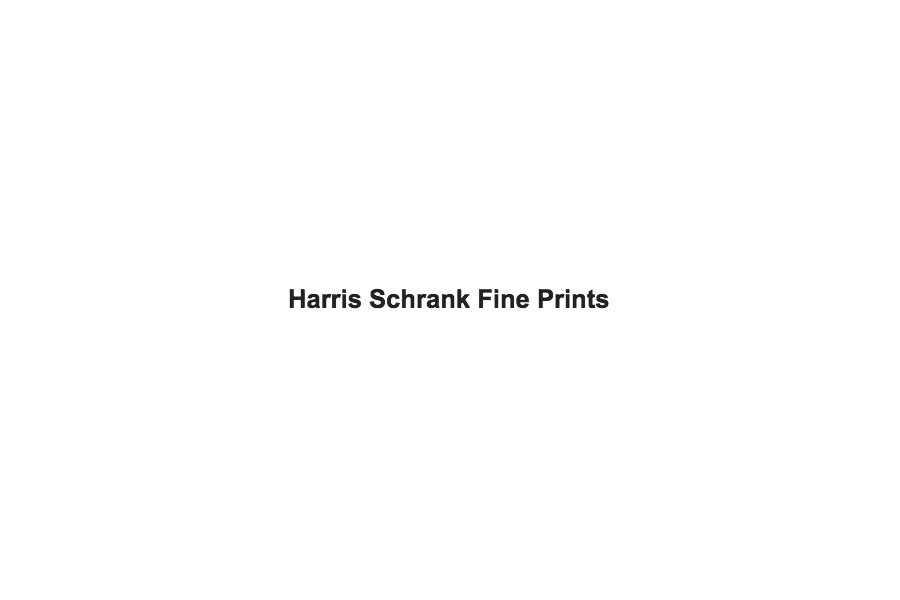
About the Seller
4.9
Recognized Seller
These prestigious sellers are industry leaders and represent the highest echelon for item quality and design.
Established in 2000
1stDibs seller since 2016
107 sales on 1stDibs
Typical response time: 6 hours
Associations
International Fine Print Dealers Association
- ShippingRetrieving quote...Shipping from: New York, NY
- Return Policy
Authenticity Guarantee
In the unlikely event there’s an issue with an item’s authenticity, contact us within 1 year for a full refund. DetailsMoney-Back Guarantee
If your item is not as described, is damaged in transit, or does not arrive, contact us within 7 days for a full refund. Details24-Hour Cancellation
You have a 24-hour grace period in which to reconsider your purchase, with no questions asked.Vetted Professional Sellers
Our world-class sellers must adhere to strict standards for service and quality, maintaining the integrity of our listings.Price-Match Guarantee
If you find that a seller listed the same item for a lower price elsewhere, we’ll match it.Trusted Global Delivery
Our best-in-class carrier network provides specialized shipping options worldwide, including custom delivery.More From This Seller
View AllStrong Girl
By Walt Kuhn
Located in New York, NY
Walt Kuhn (1877-1949), Strong Girl, drypoint, 1916 [signed in pencil by Kenneth Hays Miller and inscribed “Zinc sheet E printed by Howard Moore Park 1928”). In very good condition, printed on a cream wove paper, 7 1/2 x 5 1/4, the sheet 11 1/8 x 8 1/2 inches.
Provenance: ex Collection: The Metropolitan Museum of New York, with their stamp verso.
ex Coll: Jonathan Greenberg, New York City
A very good impression of this rare early Kuhn print.
This is listed as number 48 in the Kennedy Galleries Walt Kuhn Checklist, made for an exhibit of his prints in 1967; it is cited as a print where no more than 6 impressions are known to exist.
Kuhn was of course intimately familiar with circuses and carnivals...
Category
1910s American Modern Figurative Prints
Materials
Drypoint
Torment
By Arthur B. Davies
Located in New York, NY
Arthur B. Davies (1862-1928), Torment, soft ground etching with aquatint and roulette, 1919-20, signed with the estate stamp lower right, and signed by the printer Frank A. Nankivell...
Category
1910s American Impressionist Nude Prints
Materials
Etching, Aquatint
Tartessians
By Arthur B. Davies
Located in New York, NY
Arthur B. Davies (1862-1928), Tartessians, soft ground etching with aquatint, 1919-20, signed in pencil lower right. Reference: Czestochowski 96, second state (of 2), total printing ...
Category
1910s American Impressionist Figurative Prints
Materials
Etching, Aquatint
At the Show
By Jerome Myers
Located in New York, NY
Jerome Myers (1867-1940), At the Show, etching and drypoint, c. 1920, signed in pencil lower right. In good condition, with margins (paper losses upper corners), faint ink marks and ...
Category
1920s American Realist Figurative Prints
Materials
Drypoint, Etching
Le Ferveur
By Jean-Emile Laboureur
Located in New York, NY
Jean-Emile Laboureur (1877-1943), Le Ferveur, etching, engraving, roulette, drypoint, 1928, signed in pencil lower left, numbered lower right, and annotated “imp.” Reference: Laboure...
Category
1920s Realist Landscape Prints
Materials
Engraving, Etching
Auction
By Bernhard Kretzschmar
Located in New York, NY
Bernard Kretzschmar (1889-1972), Auction, etching, drypoint, and burnished aquatint, 1921, signed and dated (’20) in pencil lower right [also initialed in the plate lower left] Refe...
Category
1920s Expressionist Figurative Prints
Materials
Drypoint, Etching, Aquatint
You May Also Like
Estate No. 063062
By Otto Neumann
Located in New Orleans, LA
Otto Neumann (1895-1975) was an expressionist painter and printmaker born in Heidelberg, Germany. He was one of the most versatile and original artists of the twentieth century. Neum...
Category
1960s Expressionist Figurative Prints
Materials
Monotype
Bernard Sanders, (Lovers)
Located in New York, NY
Clearly Sanders (1906-1967) was a master at these minimalist figurative prints. It's all about atmosphere and tension.
Perhaps reflecting the print here, (Lovers), he, in fact, w...
Category
Early 20th Century American Modern Interior Prints
Materials
Drypoint, Etching
Kati
Located in Wien, 9
Auguste Kronheim was born in Amsterdam in 1937. The artist makes woodcuts and drawings. She received her training in drawing from Hanns Kobinger and graduated from the Linz Federal T...
Category
1960s Modern Abstract Prints
Materials
Woodcut
Estate No. 063091
By Otto Neumann
Located in New Orleans, LA
Otto Neumann (1895-1975) was a German Expressionist painter and printmaker. His monotypes evolved from sharp, angular, black and whites to late abstract prints in a variety of colors. Neumann lived through revolutionary changes in the art world of prewar and postwar Germany. He was a prolific artist in Germany during a time of the country’s unprecedented academic and intellectual growth. His early work shows the influence of both French masters like Cezanne and the contemporary style that was then being developed by German Expressionists like Kirchner. A master printmaker, Neumann was also inspired by the works of Albrecht Durer, whose allegorical subject-matter and unmatched drawing technique Neumann would emulate throughout his career. A lifetime preoccupation with the human figure informs his work, with frieze-like human figures recalling ancient Greek art...
Category
1960s Expressionist Abstract Prints
Materials
Monotype
Marcel Gromaire, Nude Woman, from Verve, Revue Artistique, 1953
By Marcel Gromaire
Located in Southampton, NY
This exquisite lithograph by Marcel Gromaire (1892–1971), titled Femme nu (Nude Woman), from Verve, Revue Artistique et Litteraire, Vol. VII, No. 27–28, originates from the 1953 issu...
Category
1950s Modern Landscape Prints
Materials
Lithograph
$716 Sale Price
20% Off
Free Shipping
Genesis 5th Day
By Dennis Ray Beall
Located in San Francisco, CA
This artwork titled "Genesis 5th Day" 1962 is a n original colors etching, with embossing by noted American artist Dennis Ray Beall, b.1929. It is hand signed, titled, dated and numb...
Category
Mid-20th Century American Modern Abstract Prints
Materials
Etching
More Ways To Browse
Circus Carnival
Chagall The Red Rider
Chagall Violin
Clerice Freres
Clint Eastwood Poster
Cowboy Etching
Cyrus Leroy Baldridge
Dali Alice Adventures
Dali Archangel
Dali Curie
Dali Demons
Dali Divine Comedy Woodcuts
Dali Immaculate Conception
Dali King David
Dali Litho
Dali Lithograph Cosmos
Dali Lobster
Dali Logician Devil

